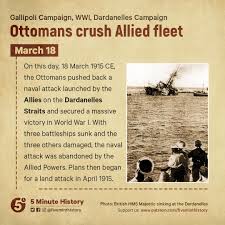Lessons from the Battlefield Part Two
Why innovation and strategy outweigh superiority in numbers
The Battle of Gallipolli 18th March 1915
“Opportunities multiply as they are seized,” says Sun
Tzu in The Art of War (5th Century B.C. military treatise).
The Allied forces won the First World War but they
suffered reverses in many battles, too. One of these was the expedition to
break through the Narrows (of the Straits of Dardanelles) leading to
Gallipolli, which was ruled by the Turkish empire.
The British navy was probably the most powerful in the
world at the time. They led the attack with twelve battleships, while the
French contributed six. The Turks knew they were no match for the Allied
forces, so they used an innovative strategy. Instead of laying a series of
mines across the Straits, they sent their mine layer Nusrat on the 7th
of March to set mines parallel to the coast on the Asiatic side of the
Dardanelles. You’ll soon see why.
#Winston Churchill was the First Lord of the Admiralty
during this war.
- Along the coast, the Turks had set up shore
batteries (large guns) to protect the entrance to the Dardanelles.
North Sea trawlers had been sent to try and clear the
watery minefield but they were easy targets for the Turkish shore batteries and
suffered major casualties.
March
18, 1915
The
British and French ships sailed into the Straits in an attempt to open a way
through the Narrows. They were subjected to intensive shelling and a fierce gun
battle ensued between the ships and the Turkish defences lodged in forts and
mobile gun batteries. The mighty ships realized they had to turn back. As they
tried to manoeuvre around, however, they struck the mines laid along the shore.
The French battleship Bouvet, which had been damaged by shell fire and was
listing hit one of the mines and sank within thirty seconds! About six hundred
men drowned.
Two
British battleships, Irresistible and Ocean sank.
The
rest of the Allied ships beat a hasty retreat.
The
Israel-Syria War of 1973
The
Battle for Golan Heights
The
Golan Heights has been described as the most hotly contested real estate on the
planet. I guess one could say that of the whole of Israel.
The
Heights is a flat plateau stretching over 1200 sq km and it overlooks Israel.
It was Syrian territory until 1967 when Israel occupied it after the
Arab-Israeli Six Days’ War.
The
Syrian Ploy
Syria
was desperate to wrest control of the Golan Heights back from Israel and they
used the Cry Wolf ploy to lull their enemy into a false state of complacency.
We’ve seen how effective this is, time and time again. Remember, Sun Tzu’s
famous statement: ‘All warfare is based on deception’?
-
The Syrians kept mobilizing troops and then recalling them to barracks. They
did this so frequently that, when they mobilized troops for a real attack in
October 1973, the Israelis thought this was just another routine exercise.
-
The Syrians were confident of victory because they had 1200 tanks equipped with
night-fighting equipment. The Middle East terrain contains long fields of fire.
There’s nowhere to hide and the Syrians considered this to be a huge advantage.
If they simply rushed at the Israelis, how could the latter retaliate when they
were heavily outnumbered with just 170 tanks?
The
Israeli Response
Once
the Israelis got over their initial shock, they gathered their defence forces
with remarkable alacrity. As a small state, surrounded by hostile countries,
Israel had perfected the art of mobilization.
-
They had dug anti-tank trenches in front of the Golan Heights.
-Although
outnumbered, the Israeli tanks were superior to the Syrians’ and could fire up
to a range of 5 kms.
-
Israel had worked hard to develop long range gunnery skills.
The
Battle
The
Syrians launched an attack by driving straight at the Israelis on the Golan
Heights and soon ran into the anti-tank trenches. It made them sitting ducks
for Israeli tanks on the Heights. They had to return quickly after suffering
debilitating losses.
-
Due to their night-fighting equipment, the Syrians launched another attack
under the cover of darkness. Their Soviet-made T-55 tanks had infrared
projectors which enabled them to see through the dark.
The
Israelis only had night vision binoculars! (They’ve come a long way since
then).
Despite
this, Israel prevailed for one important reason: superior leadership and better
strategy.
The
Syrians kept advancing straight ahead on the long, flat terrain. The Israelis,
however, kept moving about and firing, sometimes to the left, sometimes to the
right. They didn’t allow their tanks to become easy targets and managed to
pound the Syrian tanks into submission!
It’s
a testament to their success that even today, the Golan Heights remains in
Israeli possession.



No comments:
Post a Comment